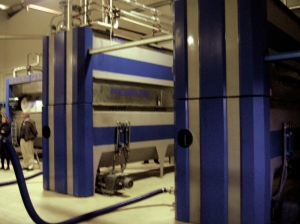Insight into Tunisian Olive Oil Production, part 2
We stood outside in a small courtyard surrounded on three sides by the typically bright white walls and blue trimmed doors / blue painted ironwork of Tunisia, which here were draped with fuchsia-colored blooming Bougainvillea festoons. Fully loaded date palms created a canopy overhead. There was birdsong and it was chilly as a wind had come up.
We are at the first commercial grower/miller appointment, and the pent-up energy of so many journalists and importers looking for olive information was a little intense. Not unlike a press event, the media crowded to the front and peppered the owner with questions from all directions. The commercial contingent of travelers chimed in with questions from time to time, too, and it was an interesting social experiment to see what happens when you put of bunch of business professionals on a bus, feed them amazing food and show them amazing cultural and historic sites for two days…and then let them loose.
Must…see…olives. Must…see…mill.
After receiving the company overview from the owner and meeting some workers in the Bougainvillea and date palm courtyard we clamored back on the bus for the long ride back through thousands of 40-60 year old Chemlali trees and on to the milling operation.
The sun was low, the sky a deep azure, and the tour bus was rocking steadily down the long unpaved tractor path on the way to the mill. There were thousands of dusty trees outside, standing more widely spaced than a conventional orchard in deeply furrowed sandy-rocky soil. The driver was playing some wonderful music — a lush fusion of chromatic Arabic modalities, North African beats and hip hop sensibility — and we were all feeling really mellow, having partially gotten through jonesing for olive info. It was a very immersive experience.
We hit the paved highway and the trees swept by more quickly, rank upon rank for many minutes, punctuated from time to time by the ubiquitous prickly pear fencing. Soon there was a large quarry, then some buildings, and finally a modern industrial zone emerged.
The business was organized as a co-op, and when olives arrived they were graded into four qualities and given lot codes by parcel. The four ton receiving bin was out front, and they had the capability to wash about 8 tons of olives per hour, or a peak season 200 tons per day. (Reminder: most of the world uses metric tons, about 10% more than our US “Short Ton”, so the capacity is 220 tons per day by US standards).
Stepping inside, past the belt elevator, we were impressed to see the Pieralisi set up: Impianto SPI 222S continuous system and Vanguard 4704 extractors with five 1 ton chambers. As a co-op they provide transportation to the growers to get the olives to the mill quickly during harvest, and assured us that “dead olives” taken from the ground were not processed with the fresh olives.
At present they are operating at about 75% capacity, or 150 tons per day during season, but then, a lot more trees are going into the ground, too. All bottling is done in Tunis, and there are single estate and monocultivar oils available as well as traditional Chemlali – Chetoui blends.
After the milling room we saw the capacious tank room and lab. Tomorrow, insha’allah, I’ll tell you about the olive oil we tasted. À bientôt!

























Liz,
Girlfriend, the words and images are as gorgeous, complex, and as richly textured as you!
Di più per favore, cara! More, please, more!
Lynnclaire
Looking forward to reading about your tasty travels.
Liz,
You are doing such a fantastic job chronicling our journey. Thanks for doing the tough job of putting it all down.